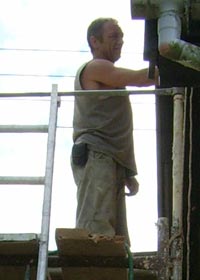Why Use Lime Render?
Traditional building construction in this local area is based on the use of relatively soft and porous materials
such as stone, brick, timber and cob, together with a lime based mortar for bedding and plastering. These
buildings usually have solid walls with no cavity, and are often built on insubstantial foundations. They are
 therefore liable to settlement and movement associated with seasonal changes in ground conditions.
therefore liable to settlement and movement associated with seasonal changes in ground conditions.
Cement render causes slightly different problems. Hairline shrinkage cracks inevitably form in the surface of the render as it sets, or afterwards by slight movement in the wall. Rainwater is drawn by suction into these cracks and then diffuses into the wall. Once inside the wall, this moisture, together with any rising damp, is trapped as it cannot evaporate through the hard impermeable render. Moisture levels start to build up in the wall and the moisture tends to diffuse towards the inner surface of the wall resulting in internal dampness and damage to plaster and decorations. So, strange as it may seem, applying a waterproof render can actually increase levels of damp inside the house. A porous lime render encourages evaporation of moisture from its surface, helping to eliminate the effects of penetrating and rising damp. See our Lime Plaster page for more information.
What About Cob walls?
Cob walls are constructed from a mixture of mud and straw that has been compacted into a broad, solid wall. Cob walls can last for over a century but, like stone walls, they are prone to seasonal movement and weather conditions. Walls and houses built of Cob (the Devonshire word for 'mud wall') need a flexible render like lime so that the wall is not damaged by brittle and immovable concrete render.
Call Andy Thompson on 07707 000027 for more information
Traditional Lime Plastering & Pointing Services